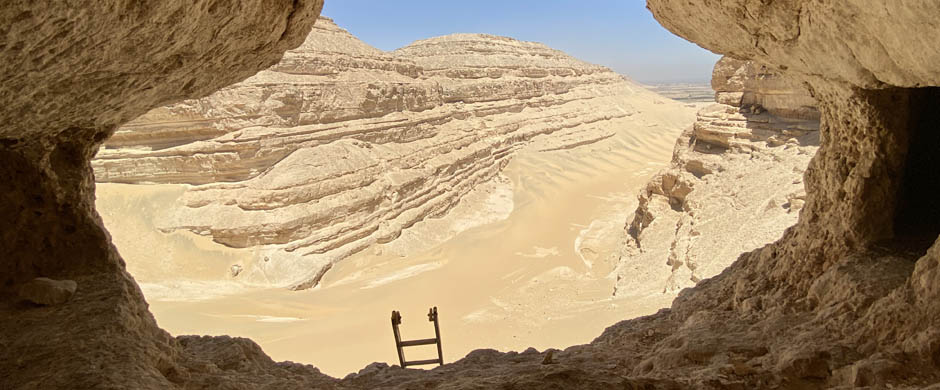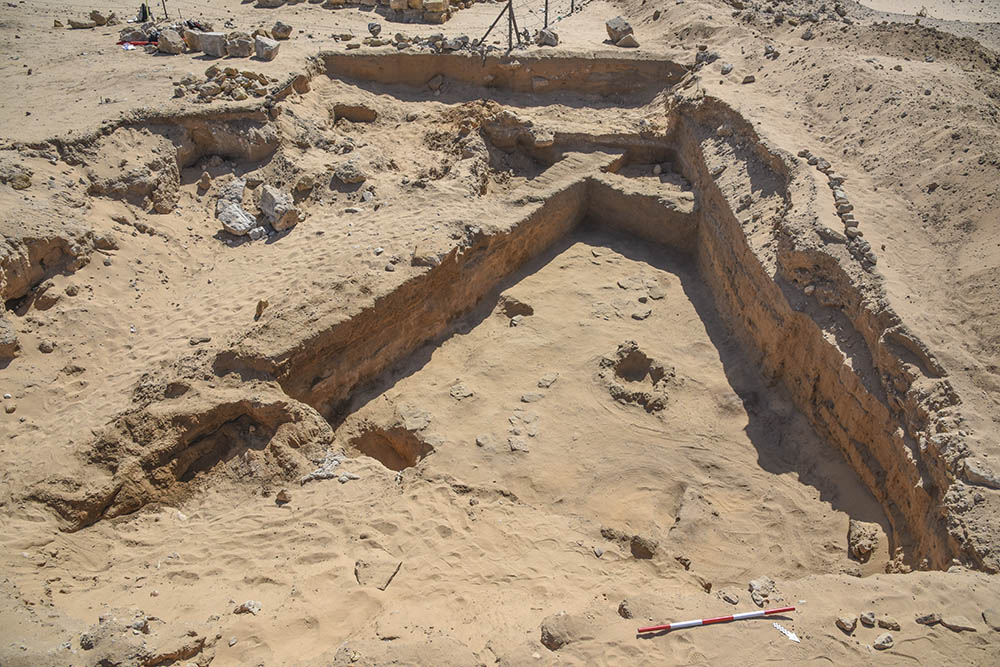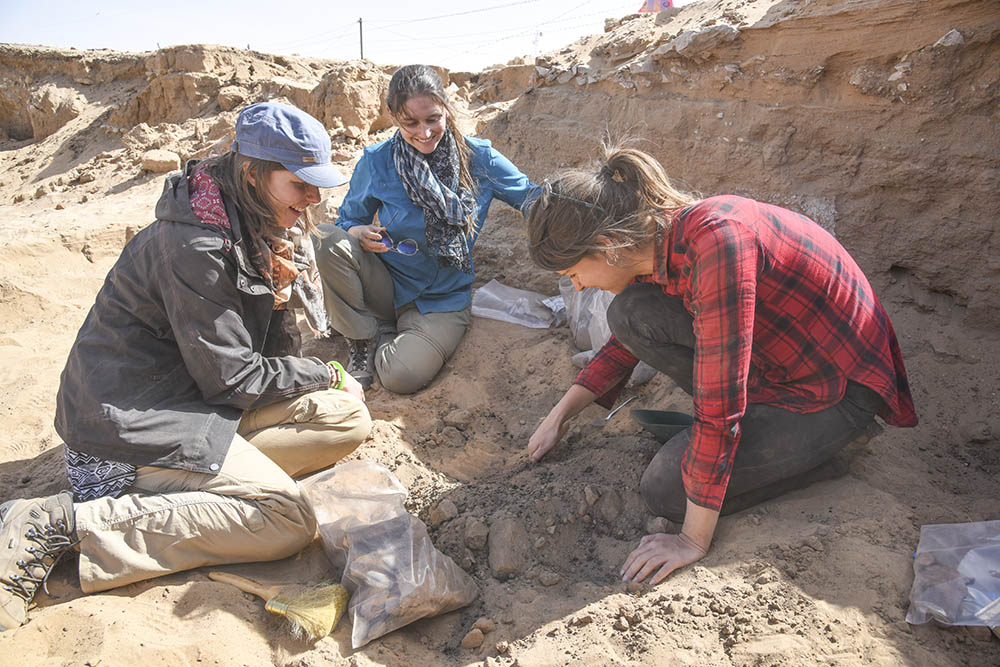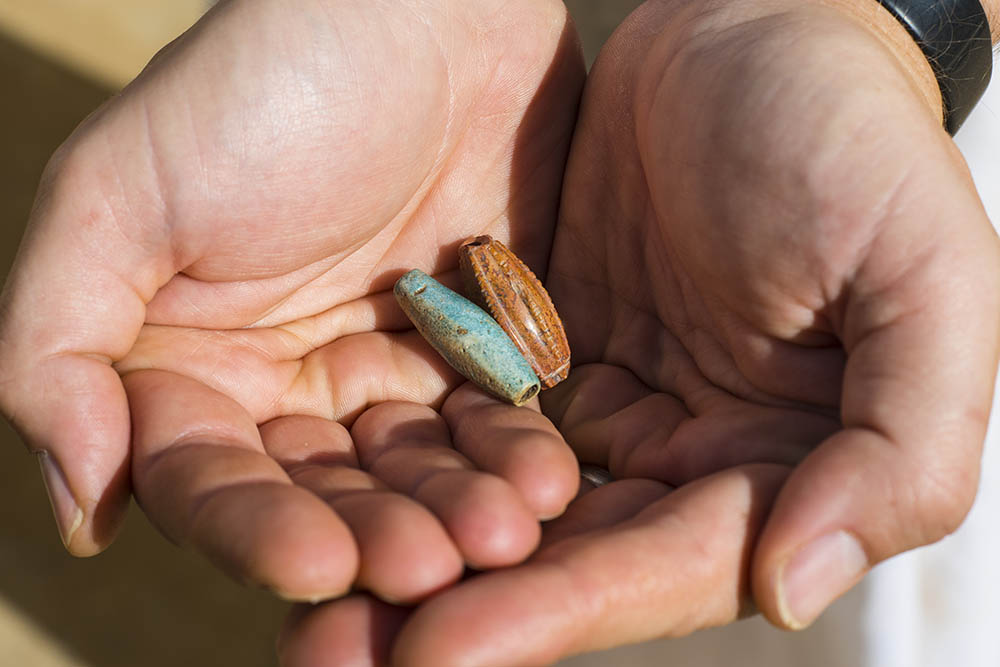 | In the Field
| In the Field

IFA Archaeology Journal
Sanam Temple 2020
 Overview of the monumental mud brick building. Several oven and production features are visible in the central exposed room, 6.5m in width.
Overview of the monumental mud brick building. Several oven and production features are visible in the central exposed room, 6.5m in width.The 2020 season of the Sanam Temple Project took place over four weeks in December 2019-January 2020, bringing together an international team of archaeologists (including two Institute students) to work with our Sudanese colleagues in and around the first millennium BCE Amun temple of King Taharqo at Sanam, Sudan. Excavations in the temple produced a variety of exciting small finds and elucidated the nature of the production areas that have been occupying us for the past few seasons, while the early monumental mud brick building found in front of the temple last year continued to surprise us.
 Conservator Celine de Ruiter, ceramicist Siobhan Shinn and excavator Chloë Ward excavate a pot emplacement in the mud brick building
Conservator Celine de Ruiter, ceramicist Siobhan Shinn and excavator Chloë Ward excavate a pot emplacement in the mud brick building In 2019 we discovered a series of extremely well-preserved mud brick walls northwest of the temple pylon, still standing to over a meter high. We returned to the area this year and were able to confirm some of our initial theories about the building, while raising many more questions about this important discovery. The sheer scale of the building continues to confound: despite greatly enlarging our exposure of the originally-discovered wall to 14.5m, we have still not identified any external corners of the building. Only one room has so far been exposed in its full length of 6.5m, verifying that this is a structure of considerable proportions with elite or even royal character. Numerous pot emplacements and oven features speak to the food preparation that took place here, along perhaps with other forms of production as shown by the discovery of a small crucible and loom weights. We have also uncovered a large number of clay tokens over the last two seasons that are known from other Sudanese sites of the first millennium BCE, but whose function remains mysterious. Most importantly, ceramic analysis and stratigraphy from this season demonstrate that the mud brick building predates the temple: we therefore have here an unprecedentedly well-preserved structure of the early first millennium BCE that will be of great importance for our knowledge of this shadowy but formative period in Nubia’s history.
Excavations in the temple continued to produce an array of interesting small finds: this season several more votive bronze Osiris figurines can be added to the small army found last year. Beads are one of the most plentiful finds from the temple, with literally hundreds recovered from some contexts. Their striking prevalence suggests that beaded jewelry was used by Nubians as an offering to the god Amun.
 Two large barrel-shaped beads recovered from the temple
Two large barrel-shaped beads recovered from the templeParticularly exquisite this year were two sizable barrel-shaped beads, one of faience and the other of carved red stone, beautifully preserved and suggestive of the impressively elaborate pieces that would have been worn and/or offered by worshippers. More decorated blocks from the temple walls also came to light, including one from the second pylon bearing the name of King Taharqo and traces of many different pigments.
As ever, our work was facilitated by the assistance and expertise of our colleagues in Sudan’s National Corporation for Antiquities and Museums, to whom we offer our heartfelt gratitude.
 The 2020 Sanam Temple Project team, including Institute students Peter Johnson and Marisa Henthorn.
The 2020 Sanam Temple Project team, including Institute students Peter Johnson and Marisa Henthorn.Our Supporters
Aphrodisias
Aphrodisias Sevenler
Derneği, Izmir
Augustus Foundation
Lucien Arkas
British Institute at Ankara
Estate of Katherine F. Brush,
in honor of Christopher Ratte
Craven Fund, Classics Faculty,
Oxford University
Mica and Ahmet Ertegun
Headley Trust
Friends of Aphrodisias, New York
Friends of Aphrodisias Trust,
London
Ömer Koç
Peter Ian Kuniholm
Leon Levy Foundation
Merops Foundation
Lys McLaughlin Pike
Janko Rasic Architects PLLC
Shuffrey Fund, Lincoln College,
Oxford
Murat Ülker and pladis
Geyre Vakfı, Istanbul
Malcolm Hewitt Wiener
Foundation, Inc.
Sanam
The Explorers Club
The Egypt Exploration Society
Samothrace
Mary Lee Baranger
Andria Derstine
ExxonMobil Foundation
Walter G. Lehmann
Lehmann Family Foundation
Loeb Classical Library Foundation
MacDonald Iliad Endowment,
Archaeological Institute of
America
National Endowment for the
Humanities
Nicholas J. Pisaris Foundation
Rush Rehm
James L. Wescoat, Sr
Selinunte
Mary Lee Baranger
Julie E. Herzig and
Robert J. Desnick
Margaret M. Miles
Victoria Newhouse
Samuel I. Newhouse
Foundation, Inc.
Judy and Michael Steinhardt
Alicia Volk and Norman H. Volk
Malcolm Hewitt Wiener
Foundation, Inc.
Institute of Fine Arts Archaeology Fund
Mary Lee Baranger
Pepi Brooks
Ethelyn Adina Gordon
Sharon R. Herson and
Daniel Fleckles
Marsa Laird
A. Floyd Lattin
Jaime L. Neary
Elizabeth A. Oustinoff
Sharon Dunlap Smith
Paul E. Stanwick
Archaeological Conservation Field School
J. M. Kaplan Fund, Inc.
This list includes contributions to the projects received from October 31, 2019 – October 31, 2020.
Contact the Institute
Building Hours
Contact Information
If you wish to receive information on our upcoming events, please subscribe to our mailing list.



